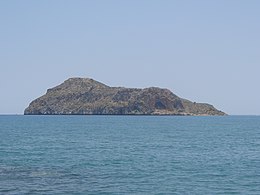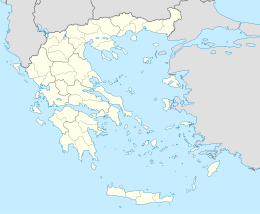Agioi Theodoroi (islands)
Native name: Άγιοι Θεόδωροι | |
|---|---|
 The islet of Agios Theodoros. | |
 Agioi Theodoroi | |
| Geography | |
| Coordinates | 35°32′13″N 23°55′52″E / 35.537°N 23.931°ECoordinates: 35°32′13″N 23°55′52″E / 35.537°N 23.931°E |
| Archipelago | Cretan Islands |
| Highest elevation | 165 m (541 ft) |
| Administration | |
Greece | |
| Region | Crete |
| Regional unit | Chania |
| Demographics | |
| Population | 0 (2001) |
Agioi Theodoroi (Greek: Άγιοι Θεόδωροι) are two uninhabited islets off the coast of western Crete. One is named Agios Theodoros, also called Thodorou, and the islet a few metres further north is called Mikros Agios Theodoros ("Little Agios Theodoros").[1] Administratively, they are part of the municipality of Platanias, in Chania regional unit. Kri-kri inhabit Agios Theodoros.[1] Anciently, the islands were known as Coete or Koite (Ancient Greek: Κοίτη) and Akytos.[2][3][4]
National park[]
In 1930 the municipality of Agia Marina with the cooperation of the hunting association of Chania decided to make the islands a nature reserve. It was in 1935 that Theodoros Viglis caught one male and two female Kri-kri in Samariá Gorge and released them on Agios Theodoros so that they could breed with integrity since no other goats inhabited the island. This initial small community of Kri-kri was too small to prevent inbreeding and more Kri-kri were introduced to the community.[1] The isolated community of Kri-kri at Agios Theodoros has been used to provide Kri-kri to zoos around the world.[5]
History[]
The islands are mentioned in antiquity (2nd half of the third century) in the Stadiasmus Maris Magni, which states that they have potable water.[3]
In 1583 the Venetians built two small fortresses on Agios Theodoros in part to prevent pirates from using the islands and in part to defend the coast of Crete.[5]
See also[]
References[]
- ^ Jump up to: a b c Thodorou Islands off Platanias ExploreCrete.com
- ^ Richard Talbert, ed. (2000). Barrington Atlas of the Greek and Roman World. Princeton University Press. p. 60, and directory notes accompanying.
- ^ Jump up to: a b Stadiasmus Maris Magni § 342.
- ^ Lund University. Digital Atlas of the Roman Empire.
- ^ Jump up to: a b Agii Theodori KretaKultur.dk
- Landforms of Chania (regional unit)
- Uninhabited islands of Crete
- Mediterranean islands
- Castles in Crete
- National parks of Greece
- Islands of Greece
- Island stubs

